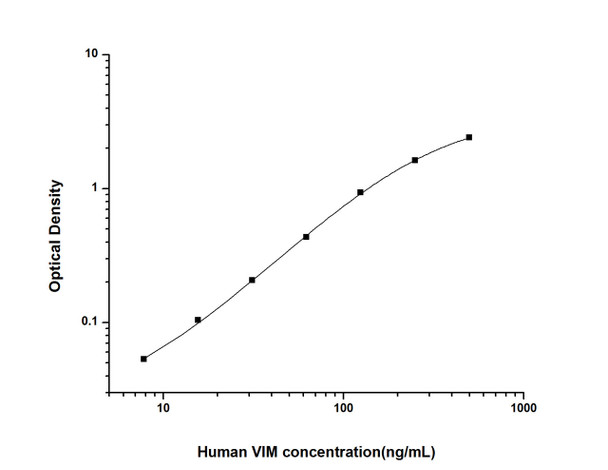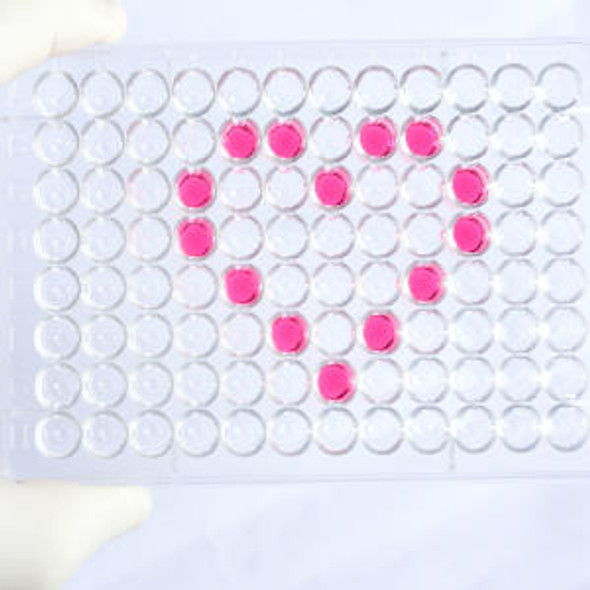Human Immunology ELISA Kits 1
Human VIM (Vimentin) ELISA Kit (HUES02188)
- SKU:
- HUES02188
- Product Type:
- ELISA Kit
- Size:
- 96 Assays
- Uniprot:
- P08670
- Sensitivity:
- 4.69ng/mL
- Range:
- 7.81-500ng/mL
- ELISA Type:
- Sandwich
- Synonyms:
- VIM, FLJ36605
- Reactivity:
- Human
- Sample Type:
- Serum, plasma and other biological fluids
- Research Area:
- Immunology
Description
| Assay type: | Sandwich |
| Format: | 96T |
| Assay time: | 4.5h |
| Reactivity: | Human |
| Detection Method: | Colormetric |
| Detection Range: | 7.81-500 ng/mL |
| Sensitivity: | 4.69 ng/mL |
| Sample Volume Required Per Well: | 100µL |
| Sample Type: | Serum, plasma and other biological fluids |
| Specificity: | This kit recognizes Human VIM in samples. No significant cross-reactivity or interference between Human VIM and analogues was observed. |
This ELISA kit uses Sandwich-ELISA as the method. The micro ELISA plate provided in this kit has been pre-coated with an antibody specific to Human VIM. Standards or samples are added to the appropriate micro ELISA plate wells and combined with the specific antibody. Then a biotinylated detection antibody specific for Human VIM and Avidin-Horseradish Peroxidase (HRP) conjugate are added to each micro plate well successively and incubated. Free components are washed away. The substrate solution is added to each well. Only those wells that contain Human VIM, biotinylated detection antibody and Avidin-HRP conjugate will appear blue in color. The enzyme-substrate reaction is terminated by adding Stop Solution and the color turns yellow. The optical density (OD) is measured spectrophotometrically at a wavelength of 450 nm ± 2 nm. The OD value is proportional to the concentration of Human VIM. The concentration of Human VIM in samples can be calculated by comparing the OD of the samples to the standard curve.
| UniProt Protein Function: | Vimentin: an intermediate filament protein. Intermediate filament proteins are expressed in a tissue-specific manner. Desmin is the subunit specific for muscle and vimentin the subunit specific for mesenchymal tissue. |
| UniProt Protein Details: | Protein type:Cytoskeletal; Motility/polarity/chemotaxis Chromosomal Location of Human Ortholog: 10p13 Cellular Component: intermediate filament cytoskeleton; neuron projection; focal adhesion; cytoskeleton; cytoplasm; leading edge; plasma membrane; intermediate filament; peroxisome; cytosol Molecular Function:protein C-terminus binding; identical protein binding; protein binding; structural constituent of cytoskeleton; double-stranded RNA binding; glycoprotein binding; structural constituent of eye lens Biological Process: Bergmann glial cell differentiation; viral reproduction; apoptosis; intermediate filament organization; cell motility; astrocyte development; cell structure disassembly during apoptosis; muscle filament sliding Disease: Cataract 30 |
| NCBI Summary: | This gene encodes a type III intermediate filament protein. Intermediate filaments, along with microtubules and actin microfilaments, make up the cytoskeleton. The encoded protein is responsible for maintaining cell shape and integrity of the cytoplasm, and stabilizing cytoskeletal interactions. This protein is involved in neuritogenesis and cholesterol transport and functions as an organizer of a number of other critical proteins involved in cell attachment, migration, and signaling. Bacterial and viral pathogens have been shown to attach to this protein on the host cell surface. Mutations in this gene are associated with congenital cataracts in human patients. [provided by RefSeq, Aug 2017] |
| UniProt Code: | P08670 |
| NCBI GenInfo Identifier: | 55977767 |
| NCBI Gene ID: | 7431 |
| NCBI Accession: | P08670. 4 |
| UniProt Related Accession: | P08670 |
| Molecular Weight: | |
| NCBI Full Name: | Vimentin |
| NCBI Synonym Full Names: | vimentin |
| NCBI Official Symbol: | VIM |
| NCBI Protein Information: | vimentin |
| UniProt Protein Name: | Vimentin |
| Protein Family: | Vimentin |
| UniProt Gene Name: | VIM |
| UniProt Entry Name: | VIME_HUMAN |
As the OD values of the standard curve may vary according to the conditions of the actual assay performance (e. g. operator, pipetting technique, washing technique or temperature effects), the operator should establish a standard curve for each test. Typical standard curve and data is provided below for reference only.
| Concentration (ng/mL) | O.D | Average | Corrected |
| 500 | 2.439 2.461 | 2.45 | 2.396 |
| 250 | 1.661 1.697 | 1.679 | 1.625 |
| 125 | 1.006 0.97 | 0.988 | 0.934 |
| 62.5 | 0.481 0.493 | 0.487 | 0.433 |
| 31.25 | 0.262 0.26 | 0.261 | 0.207 |
| 15.63 | 0.162 0.154 | 0.158 | 0.104 |
| 7.81 | 0.1 0.114 | 0.107 | 0.053 |
| 0 | 0.051 0.057 | 0.054 | -- |
Precision
Intra-assay Precision (Precision within an assay): 3 samples with low, mid range and high level Human VIM were tested 20 times on one plate, respectively.
Inter-assay Precision (Precision between assays): 3 samples with low, mid range and high level Human VIM were tested on 3 different plates, 20 replicates in each plate.
| Intra-assay Precision | Inter-assay Precision | |||||
| Sample | 1 | 2 | 3 | 1 | 2 | 3 |
| n | 20 | 20 | 20 | 20 | 20 | 20 |
| Mean (ng/mL) | 24.10 | 76.86 | 213.21 | 24.59 | 72.07 | 200.14 |
| Standard deviation | 1.34 | 4.53 | 8.38 | 1.47 | 4.12 | 7.55 |
| C V (%) | 5.56 | 5.89 | 3.93 | 5.98 | 5.72 | 3.77 |
Recovery
The recovery of Human VIM spiked at three different levels in samples throughout the range of the assay was evaluated in various matrices.
| Sample Type | Range (%) | Average Recovery (%) |
| Serum (n=5) | 95-109 | 101 |
| EDTA plasma (n=5) | 89-101 | 94 |
| Cell culture media (n=5) | 89-101 | 95 |
Linearity
Samples were spiked with high concentrations of Human VIM and diluted with Reference Standard & Sample Diluent to produce samples with values within the range of the assay.
| Serum (n=5) | EDTA plasma (n=5) | Cell culture media (n=5) | ||
| 1:2 | Range (%) | 86-101 | 87-99 | 94-106 |
| Average (%) | 92 | 94 | 100 | |
| 1:4 | Range (%) | 89-103 | 82-93 | 83-94 |
| Average (%) | 96 | 87 | 88 | |
| 1:8 | Range (%) | 88-101 | 79-89 | 87-99 |
| Average (%) | 93 | 85 | 94 | |
| 1:16 | Range (%) | 94-108 | 83-96 | 83-93 |
| Average (%) | 100 | 89 | 88 |
An unopened kit can be stored at 4°C for 1 month. If the kit is not used within 1 month, store the items separately according to the following conditions once the kit is received.
| Item | Specifications | Storage |
| Micro ELISA Plate(Dismountable) | 8 wells ×12 strips | -20°C, 6 months |
| Reference Standard | 2 vials | |
| Concentrated Biotinylated Detection Ab (100×) | 1 vial, 120 µL | |
| Concentrated HRP Conjugate (100×) | 1 vial, 120 µL | -20°C(shading light), 6 months |
| Reference Standard & Sample Diluent | 1 vial, 20 mL | 4°C, 6 months |
| Biotinylated Detection Ab Diluent | 1 vial, 14 mL | |
| HRP Conjugate Diluent | 1 vial, 14 mL | |
| Concentrated Wash Buffer (25×) | 1 vial, 30 mL | |
| Substrate Reagent | 1 vial, 10 mL | 4°C(shading light) |
| Stop Solution | 1 vial, 10 mL | 4°C |
| Plate Sealer | 5 pieces | |
| Product Description | 1 copy | |
| Certificate of Analysis | 1 copy |
- Set standard, test sample and control (zero) wells on the pre-coated plate and record theirpositions. It is recommended to measure each standard and sample in duplicate. Note: addall solutions to the bottom of the plate wells while avoiding contact with the well walls. Ensuresolutions do not foam when adding to the wells.
- Aliquot 100 µL of standard solutions into the standard wells.
- Add 100 µL of Sample / Standard dilution buffer into the control (zero) well.
- Add 100 µL of properly diluted sample (serum, plasma, tissue homogenates and otherbiological fluids) into test sample wells.
- Cover the plate with the sealer provided in the kit and incubate for 90 min at 37 °C.
- Aspirate the liquid from each well, do not wash. Immediately add 100 µL of BiotinylatedDetection Ab working solution to each well. Cover the plate with a plate seal and gently mix. Incubate for 1 hour at 37 °C.
- Aspirate or decant the solution from the plate and add 350 µL of wash buffer to each welland incubate for 1-2 minutes at room temperature. Aspirate the solution from each well andclap the plate on absorbent filter paper to dry. Repeat this process 3 times. Note: a microplatewasher can be used in this step and other wash steps.
- Add 100 µL of HRP Conjugate working solution to each well. Cover with a plate seal andincubate for 30 min at 37 °C.
- Aspirate or decant the solution from each well. Repeat the wash process for five times asconducted in step 7.
- Add 90 µL of Substrate Reagent to each well. Cover with a new plate seal and incubate forapproximately 15 min at 37 °C. Protect the plate from light. Note: the reaction time can beshortened or extended according to the actual color change, but not by more than 30min.
- Add 50 µL of Stop Solution to each well. Note: Adding the stop solution should be done inthe same order as the substrate solution.
- Determine the optical density (OD value) of each well immediately with a microplate readerset at 450 nm.






